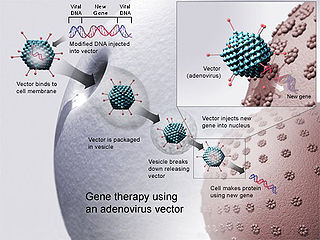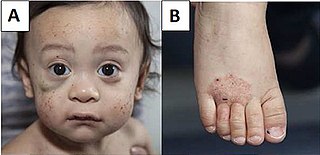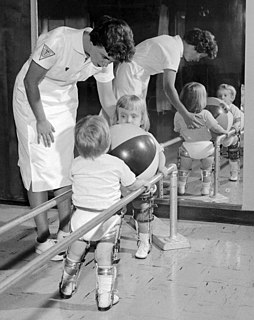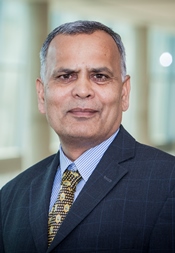
Gene therapy is a medical field which focuses on the genetic modification of cells to produce a therapeutic effect or the treatment of disease by repairing or reconstructing defective genetic material. The first attempt at modifying human DNA was performed in 1980, by Martin Cline, but the first successful nuclear gene transfer in humans, approved by the National Institutes of Health, was performed in May 1989. The first therapeutic use of gene transfer as well as the first direct insertion of human DNA into the nuclear genome was performed by French Anderson in a trial starting in September 1990. It is thought to be able to cure many genetic disorders or treat them over time.

Wiskott–Aldrich syndrome (WAS) is a rare X-linked recessive disease characterized by eczema, thrombocytopenia, immune deficiency, and bloody diarrhea. It is also sometimes called the eczema-thrombocytopenia-immunodeficiency syndrome in keeping with Aldrich's original description in 1954. The WAS-related disorders of X-linked thrombocytopenia (XLT) and X-linked congenital neutropenia (XLN) may present with similar but less severe symptoms and are caused by mutations of the same gene.

Cancer research is research into cancer to identify causes and develop strategies for prevention, diagnosis, treatment, and cure.

A designer baby is a baby whose genetic makeup has been selected or altered, often to include a particular gene or to remove genes associated with disease. This process usually involves analysing a wide range of human embryos to identify genes associated with particular diseases and characteristics, and selecting embryos that have the desired genetic makeup; a process known as preimplantation genetic diagnosis. Screening for single genes is commonly practiced, and polygenic screening is offered by a few companies. Other potential methods by which a baby's genetic information can be altered involve directly editing the genome before birth, which is not routinely performed and only one instance of this is known to have occurred as of 2019, where Chinese twins Lulu and Nana were edited as embryos, causing widespread criticism.
Malcolm K. Brenner is a British clinical scientist working mostly in the field of gene therapy and immunotherapy applied to malignancy. In 2016, Dr. Brenner was elected to the National Academy of Medicine, part of the National Academies of Sciences, Engineering, and Medicine.
European Society of Gene & Cell Therapy (ESGCT) formerly European Society of Gene Therapy (ESGT) is a legally registered professional body which emerged from a small working group in 1992 that focused on human gene therapy.
Viral vectors are tools commonly used by molecular biologists to deliver genetic material into cells. This process can be performed inside a living organism or in cell culture. Viruses have evolved specialized molecular mechanisms to efficiently transport their genomes inside the cells they infect. Delivery of genes or other genetic material by a vector is termed transduction and the infected cells are described as transduced. Molecular biologists first harnessed this machinery in the 1970s. Paul Berg used a modified SV40 virus containing DNA from the bacteriophage λ to infect monkey kidney cells maintained in culture.
Following is a list of topics related to life extension:
Primary immunodeficiencies are disorders in which part of the body's immune system is missing or does not function normally. To be considered a primary immunodeficiency (PID), the cause of the immune deficiency must not be secondary in nature. Most primary immunodeficiencies are genetic disorders; the majority are diagnosed in children under the age of one, although milder forms may not be recognized until adulthood. While there are over 430 recognized PIDs as of 2019, most are very rare. About 1 in 500 people in the United States are born with a primary immunodeficiency. Immune deficiencies can result in persistent or recurring infections, auto-inflammatory disorders, tumors, and disorders of various organs. There are currently limited treatments available for these conditions; most are specific to a particular type of PID. Research is currently evaluating the use of stem cell transplants (HSCT) and experimental gene therapies as avenues for treatment in limited subsets of PIDs.

A therapy or medical treatment is the attempted remediation of a health problem, usually following a medical diagnosis.

Sickle cell disease (SCD) is a group of blood disorders typically inherited from a person's parents. The most common type is known as sickle cell anaemia. It results in an abnormality in the oxygen-carrying protein haemoglobin found in red blood cells. This leads to a rigid, sickle-like shape under certain circumstances. Problems in sickle cell disease typically begin around 5 to 6 months of age. A number of health problems may develop, such as attacks of pain, anemia, swelling in the hands and feet, bacterial infections and stroke. Long-term pain may develop as people get older. The average life expectancy in the developed world is 40 to 60 years.
Retinal gene therapy holds a promise in treating different forms of non-inherited and inherited blindness.

Cytotherapy is a peer-reviewed medical journal covering the areas of cell and gene therapy. The journal was established in 1999 and the Senior Editor is Donald G. Phinney. It is published by Elsevier on behalf of the International Society for Cell & Gene Therapy (ISCT).
Molecular oncology is an interdisciplinary medical specialty at the interface of medicinal chemistry and oncology that refers to the investigation of the chemistry of cancer and tumors at the molecular scale. Also the development and application of molecularly targeted therapies.
Inder Mohan Verma is an Indian American molecular biologist, the former Cancer Society Professor of Molecular Biology in the Laboratory of Genetics at the Salk Institute for Biological Studies and the University of California, San Diego. He is recognized for seminal discoveries in the fields of cancer, immunology, and gene therapy.
Molecular Therapy is a scientific journal, published by Cell Press, that aims to develop and explore "molecular and cellular therapeutics to correct genetic and acquired diseases".

Ram I. Mahato is a professor and chairman of the Department of Pharmaceutical Sciences, University of Nebraska Medical Center, Omaha, United States. He was Professor of Pharmaceutical Sciences and Biomedical Engineering at the University of Tennessee Health Science Center, Memphis. He was Research Assistant Professor at the University of Utah, Senior Scientist at GeneMedicine Inc and a postdoctoral fellow at the University of Southern California in Los Angeles. Washington University in St. Louis, and Kyoto University, Kyoto, Japan. He received a PhD in drug delivery from the University of Strathclyde, UK and BS from China Pharmaceutical University, Nanjing. He is a CRS Fellow, AAPS Fellow, Permanent Member of BTSS/NIH Study section (2009–2013), and ASGCT Scientific Advisor.
Akseli Hemminki July 27, 1973 (Helsinki) is a Finnish specialist in Oncology and Radiotherapy, Professor of Oncology and founder of two biotechnology companies.

Michel Sadelain is an immunologist and genetic engineer at Memorial Sloan Kettering Cancer Center, New York, New York, where he holds the Steve and Barbara Friedman Chair. He is the founding director of the Center for Cell Engineering and the head of the Gene Transfer and Gene Expression Laboratory. He is a member of the department of medicine at Memorial Hospital and of the immunology program at the Sloan Kettering Institute. He is best known for his major contributions to T cell engineering and chimeric antigen receptor (CAR) therapy, an immunotherapy based on the genetic engineering of a patient's own T cells to treat cancer.
Maria Grazia Roncarolo is an Italian pediatrician who is currently George D. Smith Professor in Stem Cell and Regenerative Medicine and Professor of Medicine at Stanford University. She is also the Director of the Stanford Institute of Stem Cell Biology and Regenerative Medicine along with Irving Weissman and Michael Longaker and the Director for Center for Definitive and Curative Medicine at Stanford.








